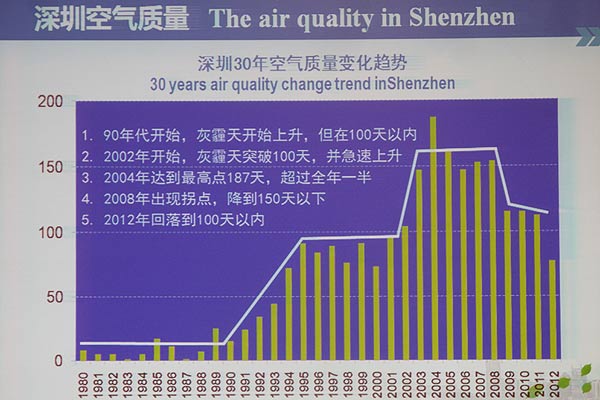Shenzhen leads in smog treatment
- By Jiao Meng
 0 Comment(s)
0 Comment(s) Print
Print E-mail China.org.cn, March 24, 2014
E-mail China.org.cn, March 24, 2014
|
|
|
Graph showing number of smog days in Shenzhen from 1980 to 2012. |
The current target for Shenzhen is to decrease the annual average Air Quality Index from 38 to 35 in the next three years, Tang Jie, vice mayor of Shenzhen in south China’s Guangdong Province said at the China Development Forum held last Friday in Beijing.
Shenzhen ranked first in air quality among China’s major cities in the first three quarters and second in the fourth quarter of 2013. However, Shenzhen experienced severe dust haze in the 2000s; and the peak was 187 days in 2004. Since then, Shenzhen began to curb air pollution, Tang Jie said.
Shenzhen’s per capita incomes are currently up to three times the national average while the carbon emissions intensity per unit of GDP is almost the lowest of China’s big cities. Consumption of gasoline and diesel has continued to decrease in the past two years. “We are trying to set the turning point of carbon emissions to the year 2017 or 18,” he said with confidence.
He listed measures taken by the city to realize low carbon development. There are about 6,300 new energy vehicles – taxis and buses – on the road, the most in any single city in the world; the electricity price in Shenzhen is almost the highest in China, which has forced high energy consumption firms to move or get pushed out in the process of industrial upgrades. Shenzhen also attaches importance to energy-saving measures, for example, new buildings must use energy saving design before their registration can be approved.
But professor Song Guojun at Renmin University of China said in an exlusive interview with china.org.cn that Shenzhen’s case was not a model which could be easily copied in China.“As a seaside city, Shenzhen has more active atmospheric circulation than the most polluted inland cities such as Beijing and cities in Hebei Province; also it has Dayawan nuclear power plant, the biggest such plant in China, to supply energy with less carbon emissions. Therefore other cities need much more input and efforts to curb air pollution,” he explained.







Go to Forum >>0 Comment(s)